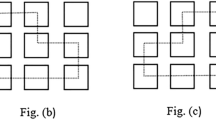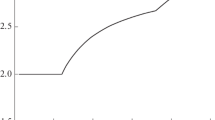Abstract
This paper presents a new construction algorithm of Quasi-cyclic low-density parity-check (QC-LDPC) codes of medium to large block-length by combining QC-LDPC codes of small block-length as their component codes, via Chinese remainder theorem. Such component codes were constructed by permuting each column block sequentially to attain the desire local girth. After combining all component codes to generate an expanded parity-check matrix, the resulting girth is greater than or at least equal to the highest girth of component codes. We investigate a lower bound for circulant permutation matrices in the proposed method, which provides efficient and fast encoding for a desired girth, and has very simple structure and more economical in terms of hardware implementation. As already proven, a high girth parameter of the parity-check matrix ensures a good error correcting performance. Thus, simulation results show that our proposed construction method of the parity-check matrix significantly outperforms the other well-known existing methods, has low error-floor, and can reduce encoding complexity for medium to large block-length QC-LDPC codes.



Similar content being viewed by others
References
Gallager, R. G. (1962). Low-density parity-check codes. IRE Transactions on Information Theory, 8(1), 21–28.
Tanner, R. M. (1981). A recursive approach to low complexity codes. IEEE Transactions on Information Theory, 27(5), 533–547.
MacKay, D. J. C., & Neal, R. M. (1997). Near Shannon limit performance of low density parity check codes. Electronics Letters, 33(6), 457–458.
Davey, M. C., & MacKay, D. J. (1998). Low density parity check codes over GF (q). In Proceedings of IEEE information theory workshop. (pp. 70–71). USA, June 1998.
MacKay, D. J. (1999). Good error-correcting codes based on very sparse matrices. IEEE Transactions on Information Theory, 45(2), 399–431.
Fossorier, M. P. (2004). Quasicyclic low-density parity-check codes from circulant permutation matrices. IEEE Transactions on Information Theory, 50(8), 1788–1793.
Li, Z., & Kumar, B. V. (2004). A class of good quasi-cyclic low-density parity check codes based on progressive edge growth graph. In Proceedings of 38th Asilomar Conference on Signals, Systems and Computers, (Vol. 2, pp. 1190–1994). Pacific Grove, CA, USA, November 2004.
Vasic, B., Pedagani, K., & Ivkovic, M. (2004). High-rate girth-eight low-density parity-check codes on rectangular integer lattices. IEEE Transactions on Communications, 52(8), 1248–1252.
Lin, S., & Costello, D. J. (2004). Error control coding: fundamentals and applications, chapter 17, vol. 114, Englewood Cliffs: Pearson Prentice Hall.
Zhang, J., & Zhang, G. (2014). Deterministic girth-eight QC-LDPC codes with large column weight. IEEE Communications Letters, 18(4), 656–659.
Fan, J. L. (2001). Array codes as LDPC codes. In Constrained Coding and Soft Iterative Decoding, (pp. 195–203). Springer USA.
Milenkovic, O., Kashyap, N., & Leyba, D. (2006). Shortened array codes of large girth. IEEE Transactions on Information Theory, 52(8), 3707–3722.
Eleftheriou, E., & Olcer, S. (2002). Low-density parity-check codes for digital subscriber lines. In Proceedings of IEEE international conference on communications, (Vol. 3, pp. 1752–1757). New York, USA, 2002.
Singhaudom, W., Noppankeepong, S., & Suphithi, P. (2007). May. Design of high-rate modified array codes for magnetic recording system. In Proceedings of 4th international conference on electrical engineering/electronics, computer, telecommunications and information technology, (pp. 553–556). ECTI, Chiangrai, Thailand, 2007.
Saadi, M., Bajpai, A., Zhao, Y., Sangwongngam, P., & Wuttisittikulkij, L. (2014). Design and Implementation of Secure and Reliable communication using optical wireless communication. Frequenz, 68(11–12), 501–509.
Zhang, Y., & Da, X. (2015). Construction of girth-eight QC-LDPC codes from arithmetic progression sequence with large column weight. Electronics Letters, 51(16), 1257–1259.
Ranganathan, S. V., Divsalar, D., & Wesel, R. D. (2015). On the Girth of (3, L) Quasi-cyclic LDPC codes based on complete protographs. doi: 10.1109/ISIT.2015.7282491.
Myung, S., & Yang, K. (2005). A combining method of quasi-cyclic LDPC codes by the Chinese remainder theorem. IEEE Communications Letters, 9(9), 823–825.
Jiang, X., & Lee, M. H. (2009). Large girth quasi-cyclic LDPC codes based on the Chinese remainder theorem. IEEE Communications Letters, 13(5), 342–344.
Karimi, M., & Banihashemi, A. H. (2013). On the girth of quasi-cyclic protograph LDPC codes. IEEE Transactions on Information Theory, 59(7), 4542–4552.
Kim, K. J., Chung, J. H., & Yang, K. (2013). Bounds on the size of parity-check matrices for quasi-cyclic low-density parity-check codes. IEEE Transactions on Information Theory, 59(11), 7288–7298.
Hu, X. Y., Eleftheriou, E., & Arnold, D. M. (2005). Regular and irregular progressive edge-growth tanner graphs. IEEE Transactions on Information Theory, 51(1), 386–398.
Mahdi, A., & Paliouras, V. (2015). On the encoding complexity of quasi-cyclic LDPC codes. IEEE Transactions on Signal Processing, 63(22), 6096–6108.
Liu, Y., Wang, X., Chen, R., & He, Y. (2008). Generalized combining method for design of quasi-cyclic LDPC codes. IEEE Communications Letters, 12(5), 392–394.
Oh, D., & Parhi, K. K. (2010). Low-complexity switch network for reconfigurable LDPC decoders. IEEE Transactions on Very Large Scale Integration (VLSI) Systems, 18(1), 85–94.
Acknowledgments
This work is part of research fund allocated to Ambar Bajpai implemented within the framework from 90th year Chulalongkorn University scholarship.
Author information
Authors and Affiliations
Corresponding authors
Rights and permissions
About this article
Cite this article
Bajpai, A., Srirutchataboon, G., Kovintavewat, P. et al. A New Construction Method for Large Girth Quasi-Cyclic LDPC Codes with Optimized Lower Bound using Chinese Remainder Theorem. Wireless Pers Commun 91, 369–381 (2016). https://doi.org/10.1007/s11277-016-3465-8
Published:
Issue Date:
DOI: https://doi.org/10.1007/s11277-016-3465-8




